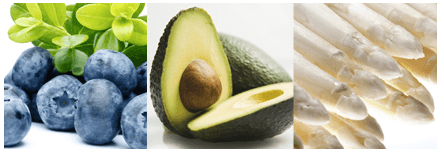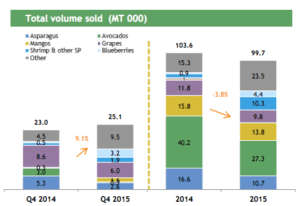Camposol: Growing fresh produce or concern?

How is Peru’s leading agro-exporter achieving record sales while tackling the challenges of climate change?
In recent years, Peru has almost become a synonym of cuisine. It has many times been named the world’s leading culinary destination, and its unique gastronomy is subject to continuous praise and awards. Peruvian food is a reflection of identity, heritage, and creativity. However, what most people don’t know is that it is mostly a reflection of a diverse set of ingredients, possible due to the country’s geography (a mix of desert coast, Andean highlands and jungle) and varied climates. [1]
Agriculture represents 6% of Peruvian GDP but accounts for over 25% percent of employment in the country and much of export growth in recent years, [2] positioning Peru as one of the top 10 food suppliers in the world with products like quinoa, asparagus, and coffee amongst others, and increasingly contributing to world food security. [3]
Camposol is the leading agro-industrial company in Peru. It harvests, processes, and markets a wide range of products, some of the main ones being hass avocados, asparagus, mangos, and shrimp, which they export to leading world markets and known retailers such as Walmart and Costco. It is also one of the top three employers in the country, and hires over 15,000 workers in peak production cycles. [4] In recent years, Camposol has been affected by climate change conditions, especially by El Nino Southern Oscillation, a naturally occurring phenomenon that involves fluctuating ocean temperatures in the equatorial Pacific, strongly related to global warming. [5]
El Nino Southern Oscillation and rising temperatures
Source: State Climate Office of North Carolina http://climate.ncsu.edu/climate/patterns/ENSO.html
El Nino Southern Oscillation, as seen in the graph above, directly affects cities in the north of Peru with rising water and air temperature, and abundant rain. It also creates fluctuations in the intensity and duration of summer and winter seasons, affecting land productivity and harvest periods. This is a main reason why in 2015, production of mangos, avocados and asparagus (all grown in the northern coastal region of Peru), dropped significantly for Camposol. [6] In addition, low yields have increased prices of certain products like hass avocados and mangos, placing them in a premium category for consumers and limiting their potential for growth.[7] It is surprising to see that in 2015, even given these tough conditions, the company registered record sales, closing Q4 2015 with revenues of USD 86.4 million, up 18.4% from Q414. [8]
Camposol Sales 2015
Source: Camposol 2015 Results Presentation, Company Documents
How is Camposol tackling climate change and what can they do looking forward?
Camposol is taking strategic measures to remain competitive in the global trade of its products. Through unique competitive advantages, a solid strategy and corporate governance it remains a growing market leader. How is it then that they are mitigating the risks of climate change and securing a better future? Mainly through the following three measures: [9]
- Diversification: Camposol is undergoing an expansion process to become a global healthy food conglomerate. Through diversification into new products and formats, the Company is able to compensate for the lower yields of their current portfolio. Their production of blueberries, for example, grew from 0.3% to 4.4% of their sales from 2014 to 2015. This strategy also allows them to maintain a baseline of sales throughout the whole year, as harvesting periods shift.
- Vertical integration: This allows for reduced variability in the production process as a whole. In addition, Camposol is able to enforce certifications, encourage best practices in land use, production and farmer training across the supply chain.
- Increasing efficiencies in seafood production: Camposol Seafood division is optimizing its farming techniques by controlling water temperature and using intensive farming, a method that optimizes the use of larvae while minimizing diseases, boosting productivity and achieving higher yields. This was the cause of shrimp and other seafood products to increase to 10.3% of sales in 2015.
Camposol is a member of the UN Global Compact, the world’s largest corporate sustainability initiative, and enforces in all its divisions certifications on good agricultural practices like responsible sourcing and clean pest control. As a market leader and aspiring global healthy food conglomerate, Camposol should aim to become a benchmark in the agriculture industry of Peru for addressing and reducing the effects of climate change. By leading by example and promoting dialogue on the subject in the region, Camposol can be a positive promoter of change.
Additionally, on a more practical level Camposol could establish clear goals around energy and water utilization Specifically, there is an opportunity to contribute to freshwater efficiency, especially in the northern region of Peru where they source shrimp and where the El Nino Southern Oscillation is more impactful. [10] Finally, due to that Camposol operated across different geographies, it would be useful implement Climate forecasting techniques that can highlight risk probabilities per region, to identify which parts of the business are more vulnerable and address the issues accordingly. [11]
Sources
[1] Marca Peru, “Peruvian Gastronomy” http://www.peru.travel/en-us/what-to-do/peru-of-today/food.aspx.
[2] http://gestion.pe/economia/sector-agrario-representa-6-pbi-emplea-mas-25-pea-2061757
[3] http://cnnespanol.cnn.com/2016/06/06/el-peru-y-las-agroexportaciones-en-el-entorno-mundial/
[4] Bloomberg, Company Overview of Camposol S.A.
http://www.bloomberg.com/research/stocks/private/snapshot.asp?privcapId=27222537/ Camposol Company Website http://www.camposol.com.pe/quienes-somos/nosotros_en.html
[5] El Nino Southern Oscillation (ENSO), State Climate Office of North Carolina http://climate.ncsu.edu/climate/patterns/ENSO.html
http://www.camposol.com.pe/inversionistas/informacion-financiera_en.html
[6] Instituto Interamericano de Cooperación para la Agricultura “El fenómeno del niño en la agricultura de las Américas” http://repiica.iica.int/docs/b3820e/b3820e.pdf
[7] Reporte “La Economia y el cambio climatico en el Peru” http://repositorio.cepal.org/bitstream/handle/11362/37419/S1420992_es.pdf?sequence=1&isAllowed=y
[8] Camposol Financial Information 2015 http://www.camposol.com.pe/inversionistas/informacion-financiera_en.html
[9] Camposol Company Documents, “Fourth Quarter 2015 and Preliminary Full Year 2015 Results” http://hugin.info/138464/R/1983586/746152.pdf
[10] Five ways Cargill is addressing climate change http://www.cargill.com/connections/five-ways-cargill-is-addressing-climate-change/index.jsp
[11] McKinsey, “How Companies can adapt to climate change” http://www.mckinsey.com/business-functions/sustainability-and-resource-productivity/our-insights/how-companies-can-adapt-to-climate-change
(800 words)





Very interesting! I am a big fan of Peruvian cuisine and have seen an increased presence of fruits and vegetables from Peru at grocery stores in the US. While it’s interesting that Camposol has continued to see record sales despite the lower yields, I think a main driver of this is the increased price. This poses a risk though, as many consumers will not be willing to consistently pay the higher prices and will shift to products that are more budget-friendly. As Camposol seeks to grow, it becomes more important that they do so in a sustainable and diversified way.
Nicole, thanks for your post it was so interesting! I would like to add the impacts that El Niño is having in other economic activities beside agriculture.
I used to work for a shopping centers developer and we constructed in all major peruvian cities. One of our biggest problems, specially in the northern part, was that every year the season when we could build the shopping centers was shorter because of the heavy rains that we had to face. This caused as a delay in the openening date, which is one of the most critical aspects of the business.
In addition to that we also faced serious problems because of the floods that El Niño caused. In fact one of our shopping centers was completely flooded and all of our electrical systems were placed in the basement so became seriously damaged. After that we decided that the electric systems should be placed on the roofs to avoid this problems, even if was more expensive to design it like that.
This is very thought provoking Nicole. It’s inspiring to see leading companies in developing countries setting the stage for a more environmentally-friendly business atmosphere. El niño’s impact on drastic climate change around the world is evident but I’m wondering if the adversities Campostol is going through can also be attributed to other factors different than el niño. If so, do you think Campostol is ready to tackle additional issues?